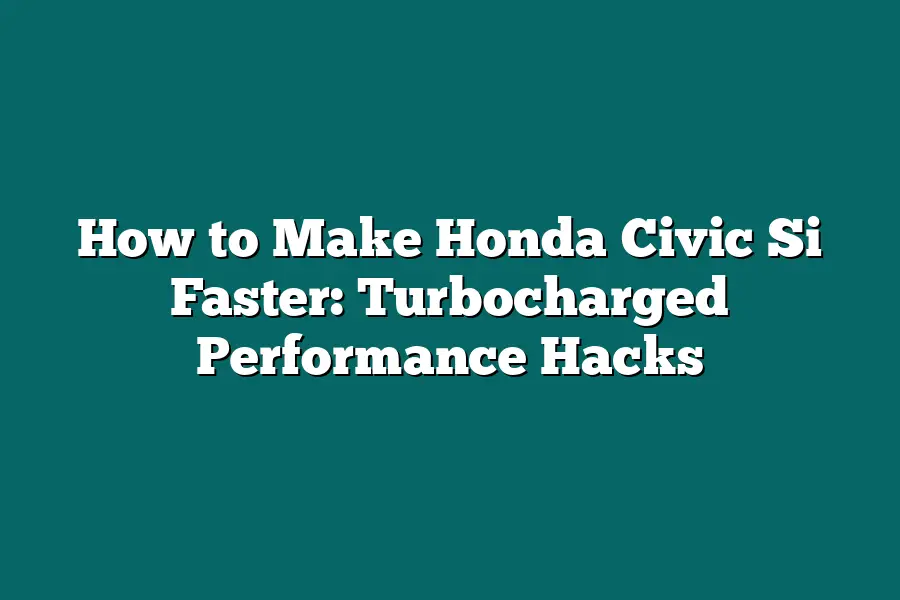To make a Honda Civic Si faster, consider upgrading its engine performance by adding a cold air intake or a cat-back exhaust system. You can also install lightweight wheels and tires to improve handling and acceleration. Additionally, fine-tuning your suspension with stiffer springs or sway bars can enhance cornering ability. Finally, upgrade your transmission’s gear ratios for a more responsive and quicker shifting experience.
As a Honda Civic Si enthusiast, I’ve always been fascinated by the thrill of unleashing its true potential.
And what better way to do that than with turbocharged performance hacks?
With the right combination of tweaks and upgrades, you can take your Civic Si from a humble daily driver to a track-ready beast.
But where do you start?
In this series of posts, I’ll be sharing my expertise on how to make your Honda Civic Si faster – without sacrificing reliability or durability.
From choosing the perfect turbocharger to upgrading the fuel and cooling systems, we’ll dive deep into the nitty-gritty details that’ll get you there.
Whether you’re a seasoned tuner or just starting out, this guide is designed to help you accelerate your journey towards turbocharged awesomeness.
So buckle up, because it’s time to take your Honda Civic Si to the next level!
Table of Contents
Step 1: Choose the Right Turbocharger
When it comes to making your Honda Civic Si faster, there are many ways to get the job done.
But if you’re looking for a game-changing boost in power and performance, turbocharging is one of the most effective routes to take.
And when it comes to choosing the right turbocharger for your ride, things can get real complicated real fast.
I mean, have you seen the sheer variety of turbochargers out there?
From bolt-on units that are as easy to install as a new phone case, to hybrid systems that combine turbocharging with supercharging or nitrous oxide injection – it’s like trying to order from a menu at a 5-star restaurant!
So, how do you choose the right one for your Civic Si?
Well, let me tell you, it all comes down to boost pressure.
Yeah, I know what you’re thinking: “Boost pressure?
That sounds like rocket science!” But trust me, it’s not as complicated as it seems.
The thing is, different turbochargers are designed to produce different levels of boost pressure – and that affects everything from power output to engine longevity.
For example, if you’re looking for a mild boost that just gives your Civic Si a little extra oomph, a bolt-on turbocharger with a modest 5-7 psi boost might be the way to go.
On the other hand, if you’re looking to unleash a beast of a performance car that’ll leave all the haters in the dust, you might need something more serious – like a hybrid turbocharger capable of producing 15-20 psi or more.
Just remember: when it comes to boost pressure, more isn’t always better.
Another key consideration is airflow.
Think about it like this: if your turbocharger is only capable of producing a certain amount of boost pressure, but your engine can’t handle the extra air and fuel being forced into it, you’re just going to end up with a bunch of wasted horsepower.
So, how do you find the right balance between boost pressure and airflow?
Research, my friend!
Read reviews, talk to other Civic Si owners who’ve gone down the turbocharging route, and don’t be afraid to consult with a professional mechanic or performance specialist if you’re not sure what you’re doing.
And remember: when it comes to choosing the right turbocharger for your Honda Civic Si, there’s no one-size-fits-all solution.
It all depends on your specific needs, goals, and budget.
So take your time, do your research, and don’t rush into anything that might leave you feeling like you’ve got a bunch of useless junk stuck to your engine.
Step 2: Install the Turbocharger: Where the Magic Happens
Now that we’ve covered the basics of turbocharged performance, it’s time to dive into the meat of the matter – installing the turbocharger itself.
This is where the rubber meets the road (or should I say, where the turbocharger meets the engine?).
In this step, we’ll explore the two main installation options: bolt-on and custom fabrication.
Bolt-On vs. Custom Fabrication: Which Route Should You Take?
When it comes to installing a turbocharger, you’ve got two primary choices: a bolt-on solution or a custom fabrication job.
Here’s what you need to know:
- Bolt-On: A bolt-on installation is the most straightforward and accessible option. It involves attaching the turbocharger to your engine using existing mounting points and connectors. This approach is perfect for those who want to get started with turbocharging without breaking the bank or requiring extensive mechanical expertise.
- Custom Fabrication: On the other hand, a custom fabrication job requires more time, effort, and resources. This option involves designing and building a bespoke turbocharger system that’s tailored to your specific engine and performance goals. If you’re looking for maximum power gains and don’t mind investing in a higher-priced solution, this might be the way to go.
Tips for a Proper Installation and Alignment
Regardless of which installation route you choose, proper installation and alignment are crucial for ensuring optimal turbocharged performance.
Here are some key considerations to keep in mind:
- Consult with a pro: If you’re not comfortable with the installation process or don’t feel confident in your mechanical abilities, consult with a professional mechanic or performance specialist. They’ll help you navigate any challenges and ensure a smooth installation.
- Check your modifications: When installing a turbocharger, it’s essential to make sure all necessary modifications are made to support the increased boost pressure and airflow. This includes upgrading your engine management system, exhaust system, and possibly even your transmission.
By following these steps and considering these tips, you’ll be well on your way to unleashing the full potential of your Honda Civic Si with a turbocharged performance hack.
In our next step, we’ll explore how to optimize your turbocharger’s performance using boost controllers and wastegates.
Stay tuned!
Step 3: Upgrade the Fuel System – Turbocharged Performance Hacks
Now that we’ve got our turbocharger installed, it’s time to make sure our Honda Civic Si can feed that extra boost pressure.
Think of your fuel system like a hungry teenager – if you don’t give it enough grub, performance suffers.
In this step, I’ll walk you through the essential upgrades needed for turbocharged performance.
The Lowdown on Fuel System Upgrades
When it comes to turbocharged performance, a well-designed fuel system is crucial.
You see, increased boost pressure and airflow require more fuel to be delivered at the right time.
That’s where upgraded injectors, pumps, and lines come in.
A quality fuel system will keep your engine running smoothly, while also preventing those pesky knock or ping issues.
Key Considerations for Selecting the Right Fuel System Components
Upgrading your fuel system can be a daunting task, especially if you’re new to performance modifications.
Here are some key considerations to keep in mind when selecting the right components:
- Research and Read Reviews: Don’t just grab any old fuel system parts off the shelf. Take the time to research and read reviews from other enthusiasts who’ve used similar components. This will give you an idea of their quality, durability, and performance.
- Consult with a Professional Mechanic or Performance Specialist: If you’re not familiar with fuel system upgrades, don’t be afraid to seek guidance from a professional mechanic or performance specialist. They can help you choose the right components for your specific setup.
Some popular options for fuel system upgrades include:
- High-flow injectors: These allow more fuel to flow into your engine, which is essential for turbocharged performance.
- Fuel pumps: Upgraded fuel pumps provide increased pressure and flow rates, ensuring that your engine gets the fuel it needs to run efficiently.
- Fuel lines and hoses: High-quality fuel lines and hoses are designed to withstand increased boost pressure and airflow.
Remember, a well-designed fuel system is critical for maintaining performance and preventing issues like fuel starvation or lean conditions.
By following these tips and upgrading your fuel system, you’ll be able to harness the full potential of your Honda Civic Si’s turbocharged engine.
Step 4: Upgrade the Cooling System – The Turbocharged Performance Hack You Can’t Ignore
As we dive deeper into the world of turbocharged performance hacks for your Honda Civic Si, it’s time to talk about one of the most crucial – yet often overlooked – components: the cooling system.
When you’re pushing your engine to new heights with increased boost pressure and airflow, a reliable cooling system is more important than ever.
Why Your Cooling System Needs an Upgrade
A traditional radiator designed for stock power levels might not be enough to handle the heat generated by a turbocharged engine.
Without proper cooling, your engine can quickly overheat, leading to decreased performance, reduced fuel efficiency, and potentially even engine damage.
It’s like trying to cook a meal in a kitchen without any air circulation – it just won’t work!
Key Considerations for Selecting the Right Cooling System Components
Upgrading your cooling system requires careful consideration of several key factors:
- Compatibility: Make sure the new components are compatible with your Honda Civic Si’s engine and transmission.
- Flow Rate: Choose components that can handle increased airflow and boost pressure. A high-flow radiator, for example, is essential for turbocharged performance.
- Quality: Research and read reviews to find high-quality cooling system components that can support your power upgrades. Don’t skimp on quality – it’s better to invest in a few key components than to replace them all down the line.
Tips for Sourcing High-Quality Cooling System Components
When searching for the right cooling system components, keep these tips in mind:
- Research: Look up reviews and ratings from other performance enthusiasts who have installed similar upgrades.
- Consult with a Pro: If you’re not familiar with cooling system upgrades, consult with a professional mechanic or performance specialist. They can help you make informed decisions and avoid costly mistakes.
By upgrading your cooling system to support increased boost pressure and airflow, you’ll be able to unlock the full potential of your Honda Civic Si’s turbocharged engine.
In the next step, we’ll explore another critical component that will take your performance to the next level – stay tuned!
Final Thoughts
As I wrap up this turbocharged performance hack guide, I’m reminded of the excitement and satisfaction that comes from unleashing your Honda Civic Si’s full potential.
By choosing the right turbocharger, installing it correctly, upgrading the fuel system, and ensuring proper cooling, you’ll be able to tap into a whole new world of power and speed.
It’s not just about numbers on a dyno sheet – it’s about the thrill of driving a car that truly reflects your passion for performance.
So, what are you waiting for?
Get out there and make some noise with your turbocharged Civic Si!

